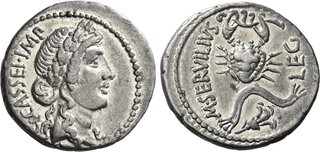| Numismatica Ars Classica > Auction 143 | Auction date: 7 May 2024 |
| Lot number: 411 Price realized: This lot is for sale in an upcoming auction - Bid on this lot  | Show similar lots on CoinArchives Find similar lots in upcoming auctions on |
| Lot description: The Dioscuri Collection. The Roman Republic. C. Cassius and M. Servilius. Denarius, mint moving with Brutus and Cassius 43-42, AR 19 mm, 3.76 g. C·CASSEI·IMP Laureate head of Libertas r. Rev. M·SERVILIVS – LEG Crab, holding aplustre in its claws; below, rose and untied diadem. Babelon Cassia 19 and Servilia 40. C 10. Sydenham 1313. Sear Imperators 226. Crawford 505/3. Extremely rare and in unusually fine condition for this difficult and fascinating issue. Struck on very fresh metal and about extremely fine Ex NAC sale 100, 2017, 388. Alongside Brutus, C. Cassius Longinus was a leading figure in the plot to assassinate Julius Caesar. However, things did not quite go according to plan. While the so-called Liberators had imagined that the removal of Caesar would allow for the full restoration of the Roman Republic under the leadership of the senatorial class, they had not counted on the admiration of the general public for the dictator and the ability of his legal and political heirs, Octavian and Mark Antony, to turn the people of Rome against them. Realising that the situation was rapidly deteriorating for Caesar's assassins in Italy, most of the Liberators, including Cassius took up provincial posts in the East in order to build the war chests and legions that would be needed for their inevitable final showdown with the Caesareans. Cassius first went to Syria, where he was well known from his previous tenure there as governor in 53-2 BC, in order to raise money before proceeding to Asia Minor to link up with Brutus. This extremely rare denarius type was struck in the names of Cassius and his legate M. Servilius at a military mint moving with Cassius and Brutus in 42 BC. It was probably produced when Cassius and Brutus met for the last time at Sardis before embarking on the fateful Philippi campaign. The obverse type depicts Libertas, the Roman personification of freedom, who was deemed to have been restored to the Roman people with each dagger blow of Caesar's assassins. The reverse symbolically celebrates Cassius' capture of the wealthy trading city of Rhodes. The Rhodians (symbolised here by the well-known rose badge of their city), a long established their naval power, had attempted to prevent the Liberator's plunder of their island city by challenging him at sea between Myndos and the island of Cos (whose civic badge was a crab), they were soundly defeated by the forces of Cassius, which had long been training for the battle. The victory of Cassius is here indicated by the aplustre (the cut-off stern post of a war galley) held in the claws of the Coan crab. Upon his entry to Rhodes, the fearful Rhodians are said to have hailed Cassius as their "lord and king." He, however, refused to accept this title, reportedly responding, I am neither lord and king, but I have punished the man who would have been both." This denial of kingship is indicated by the untied royal diadem depicted fallen to the ground above the Rhodian rose. Interestingly, while Cassius denied that he would be a king, he made no similar denial about being a thief. Once he had entered Rhodes, he plundered the city of some 8,000 talents to be used in financing the coming war against Octavian and Antony. It is not impossible that coins such as this were actually produced from the silver carried off from the island city. Estimate: 15000 CHF |  |



